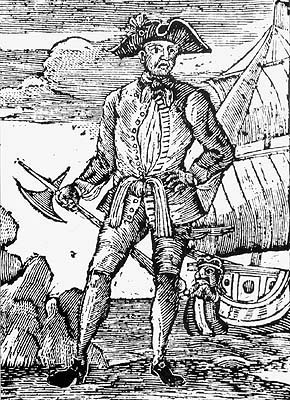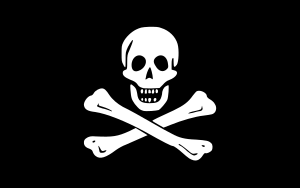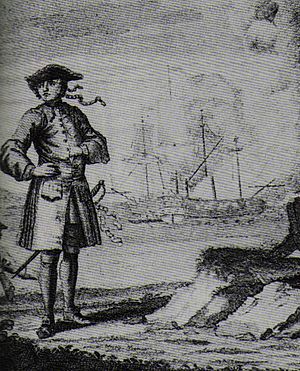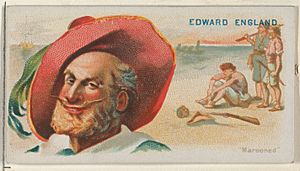Edward England facts for kids
Quick facts for kids
Edward England
|
|
|---|---|

An 18th century woodcut of England
|
|
| Born | c. 1685 |
| Died | 1720/21 (aged approximately 36) St. Augustine's Bay, Merina Kingdom
|
| Piratical career | |
| Nickname | Ned |
| Type | Pirate Former privateer |
| Allegiance | Kingdom of Great Britain (War of the Spanish Succession) |
| Rank | Captain |
| Base of operations | Southern Africa |
| Commands | Several vessels, most famously the Royal James and the Fancy. |
| Battles/wars | Battle with the Cassandra that caused his crew to mutiny and maroon him for sparing some captives. |
Edward England (born around 1685, died 1720 or 1721) was a famous Irish pirate. He sailed on ships like the Pearl, which he renamed The Royal James. Later, he swapped it for a ship called the Fancy in 1720. His pirate flag was the classic Jolly Roger. It showed a human skull above two crossed bones on a black background. This flag was very similar to the one used by "Black Sam" Bellamy. Like Bellamy, Edward England was known for being a kind and fair leader. This was quite unusual for pirates of his time.
England was born Edward Seegar in Ireland. This was around the year 1685. He first joined an expedition to find sunken treasure off the coast of Florida. Then, he started sailing with another pirate, Charles Vane, in 1718. When Vane and other pirates accepted the King's Pardon, England and some of his crew sailed to Africa. On his journey, he helped start the pirate career of Bartholomew Roberts. In 1720, near the African island of Comoros, England and his crew had a big fight with Captain James Macrae. After hiding on an island for ten days, England and Macrae agreed to a peace deal. This made England's crew very angry. They voted him out as captain and left him on the island of Mauritius. After four months, England and his loyal crewmates built a small boat. They sailed to a pirate safe haven in Madagascar. He passed away sometime in the winter of 1720–21. It's thought he might have died from a tropical disease.
Contents
Edward England: The Pirate Captain
Early Life and Beginnings
Edward England was born in Ireland around 1685. His birth name was Edward Seegar. People believed he was educated. He changed his last name to England when he became a pirate. Some stories say "Seegar" was actually another pirate, Jasper Seagar, who sailed with England.
England traveled to Jamaica. During the War of the Spanish Succession, he worked as a privateer. This meant he was like a legal pirate, attacking enemy ships for his country. He was later captured by a pirate captain named Christopher Winter. Winter forced England to join his pirate crew. Winter then took England to the pirate base in Nassau, Bahamas.
Becoming a Pirate
England took part in Henry Jennings' attack on a Spanish treasure camp in Florida. They stole a lot of gold and silver. After this, England became the quartermaster for Charles Vane. A quartermaster was an important role on a pirate ship. In March 1718, Vane's ship was captured by the Royal Navy. But England and his crew were set free. This was done to encourage other pirates to accept the King's pardon.
Captaincy and African Adventures
England became a captain of his own ship in mid-1718. He decided not to accept the King's pardon. Instead, he and a few others sailed towards the coast of Africa.
Adventures in Africa
On their way, England and his crew captured several ships. One ship was the Cadogan from Bristol. Its captain was a man named Skinner. Some of England's crew knew Skinner. They remembered he had not paid them for their work before.
The pirates treated Captain Skinner very harshly. Because he had been a good leader to his own men, they gave him a quick end. The crew of the Cadogan now had no captain. England offered them a choice: join his crew. A sailor named Howell Davis was on board. He refused to become a pirate. England did not kill him. Instead, he gave Davis command of the captured ship. This was the start of Davis's pirate career. Davis later helped start the career of Bartholomew Roberts and many other pirates.
After some time, England and his crew captured a larger ship called the Pearl. They took this ship for themselves. They renamed it the Royal James. This name honored James Stuart. In the spring of 1719, they sailed to Africa to find more treasure. Between the Gambia River and the Cape Coast, they captured and looted ten ships. They kept two of these ships. They gave them to Captains Robert Lane and Richard Sample. These captains then sailed to the Caribbean.
After looting the ten ships, England made John Taylor the captain of his next captured ship, the Victory. After looting two more ships, England and his crew decided to stop at a small African town. However, the pirates caused trouble with the local people. A fight broke out. The pirates ended up damaging the town before leaving.
Battles in the Indian Ocean
By 1720, England had reached the Indian Ocean. There, he met another pirate captain, Oliver la Buse. England captured a large Dutch ship with thirty-four guns. He named it the Fancy. This was to honor the English pirate Henry Every. The Fancy became his new main ship.
England decided to attack an East Indiaman ship. This was a large trading vessel. It was commanded by James Macrae and called the Cassandra. The attack happened near the island of Comoros. A long and fierce battle took place. Both ships ended up stuck on the ground. Macrae and his surviving crew escaped. They hid on the island for ten days.
Finally, Macrae, who was hurt, tired, and hungry, went to England's other ship, the Victory. He hoped for mercy and surrendered to the pirates. The cargo on the Cassandra was very valuable. Ninety of the Fancy's crew died in the attack. England was known for his kind nature. He usually did not harm captives unless it was absolutely necessary. England ordered that Macrae's life be spared. The pirates kept the Cassandra. They gave the badly damaged Fancy to Macrae.
This decision made many pirates angry, especially Taylor. Taylor had wanted to kill Macrae. Around this time, Taylor organized a vote to remove England from being captain. The new captain was a former member of the Fancy crew named Jasper Seator. He left England and three others on the coast of Mauritius. This is called marooning. Seator then took the Cassandra and Victory north to find more treasure. Seator died in 1721. The Cassandra eventually went to Taylor, who took it to the Caribbean.
Marooned!
England and his three friends were left on the shore without enough supplies. They had to search for food and water. After about four months, the men managed to build a small boat. They sailed to a pirate safe place called St. Augustine's Bay in Madagascar.
His Legacy
After arriving at St. Augustine's Bay, England lived for a while. Other pirates helped him, possibly some of Henry Every's old crew. He died in late 1720 or early 1721. He might have died from a tropical disease.
Edward England's son, John, followed his father's wish. He also named his own son John. This tradition continued through England's family.
Today, Edward England is remembered as one of the more humane pirate captains. He lived during the Golden Age of Piracy.




